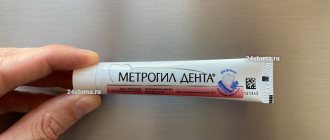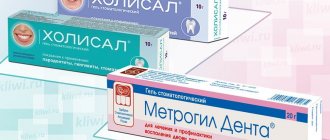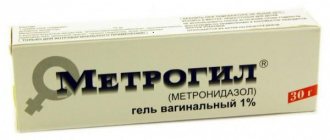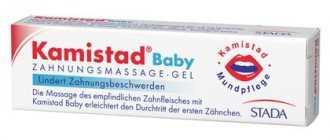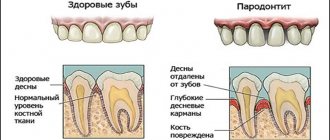Compound
The Metrogyl solution contains the active ingredient metronidazole , as well as: sodium chloride, sodium hydrogen phosphate (anhydrous), citric acid, water.
Metrogyl tablets contain the active ingredient metronidazole , as well as: corn starch, magnesium stearate, colloidal silicon dioxide, hydrogenated castor oil, Opadry II dye, water.
Metrogyl gel includes metronidazole and additional components: propyl parahydroxybenzoate, methyl parahydroxybenzoate, disodium edetate, carbomer 940, sodium hydroxide, propylene glycol, water.
Release form
Currently, Metrogyl solution is produced for intravenous administration, as well as tablets, vaginal gel and gel for external use.
- The solution for intravenous administration can be colorless or pale yellow, transparent, packaged in transparent ampoules of 20 ml (100 mg solution) and in polyethylene bottles of 100 ml (500 mg solution). The containers are placed in cardboard packs.
- Tablets 200 mg - pink, biconvex, film-coated, round, packaged in blisters of 10 pcs., in cardboard packs of 2 blisters.
- Tablets 400 mg - orange, biconvex, film-coated, round, packaged in blisters of 10 pcs., in cardboard packs of 2 blisters.
- Metrogyl vaginal gel is homogeneous, colorless or has a yellow tint, contained in tubes of 30 g.
pharmachologic effect
The broad-spectrum medicine contains metronidazole , a 5-nitroimidazole derivative.
The drug has antimicrobial and antiprotozoal effects. The mechanism of action is based on the reduction of the 5-nitro group of metronidazole by intracellular transport proteins of anaerobic microorganisms and protozoa. The 5-nitro group of metronidazole interacts with the DNA of microbial cells, inhibiting the synthesis of their nucleic acids. As a result, the bacteria die.
Metrogyl demonstrates activity against Gardnerella vaginalis, Trichomonas vaginalis, Giardiai ntestinalis, Entamoeba histolytica, Lamblia spp. The drug is also active against obligate anaerobes and a number of gram-positive microorganisms.
If metronidazole is combined with Amoxicillin , activity against Helicobacter pylori is manifested.
Facultative anaerobes and aerobic microorganisms do not show sensitivity to metronidazole, however, in the presence of mixed flora, there is a synergistic effect of metronidazole with antibiotics that are effective against aerobes.
It provokes disulfiram-like reactions, under its influence the sensitivity of tumors to radiation increases, and reparative processes are stimulated.
When applied externally, an anti-acne effect is observed, the mechanism of which is not fully known. Metrogyl ointment appears to demonstrate antioxidant activity. Under the influence of this drug, the production of active oxygen, hydrogen peroxide, and hydroxyl radicals by neutrophils is reduced, that is, potential oxidants that contribute to tissue damage in the place where the inflammatory process develops.
The external form of the drug is active against telangiectasia in rosacea .
Instructions for use METROGYL
Mechanism of action
Nitroimidazoles are synthetic AMPs with high activity against anaerobic bacteria and pathogens of protozoal infections. The first drug of the group, metronidazole, was approved for medical use in 1960. Nitroimidazoles have a selective bactericidal effect against those microorganisms whose enzyme systems are capable of reducing the nitro group. Active reduced forms of drugs disrupt DNA replication and protein synthesis in microbial cells and inhibit tissue respiration. Nitroimidazoles are active against most anaerobes - both gram-negative and gram-positive:
- bacteroides (including B. fragilis), clostridia (including C. difficile), Fusobacterium spp., Eubacterium spp., Peptostreptococcus spp., P. niger, G. vaginalis. P. acnes is resistant. Protozoa (T.vaginalis, E.histolytica, G.lamblia, L.intestinalis, E.coli, Leishmaniaspp.), as well as H.pylori, are sensitive to nitroimidazoles.
The mechanism of action is the biochemical reduction of the 5-nitro group of metronidazole by intracellular transport proteins of anaerobic microorganisms and protozoa. The reduced 5-nitro group of metronidazole interacts with the DNA of microbial cells, inhibiting the synthesis of their nucleic acids, which leads to the death of bacteria.
Active against Trichomonas vaginalis, as well as gram-negative anaerobes Bacteroides spp. (including Bacteroides fragilis, Bacteroides distasonis, Bacteroides ovatus, Bacteroides thetaiotaomicron, Bacteroides vulgatus), Fusobacterium spp. and some gram-positive microorganisms (susceptible strains of Eubacterium spp., Clostridium spp., Peptococcus spp., Peptostreptococcus spp.). The MIC for these strains is 0.125-6.25 μg/ml.
When applied externally, it has an anti-acne effect, the mechanism of which is precisely unknown (not related to the effect on the Demodex folliculorum mite, found in hair follicles and the secretion of the sebaceous glands, and any effect on the production of this secretion).
Metronidazole for external use may have antioxidant activity. It has been found that it significantly reduces the production of active oxygen, hydroxyl radicals and hydrogen peroxide by neutrophils, which are potential oxidants that can cause tissue damage at the site of inflammation. Metronidazole for external use is ineffective against telangiectasias noted with rosacea.
Aerobic microorganisms and facultative anaerobes are insensitive to metronidazole, but in the presence of mixed flora (aerobes and anaerobes), metronidazole acts synergistically with antibiotics effective against common aerobes.
Pharmacokinetics and pharmacodynamics
After a patient has been administered Metrogyl intravenously, approximately 30-60% of the substance is metabolized through hydroxylation, oxidation and glucuronidation. As a result, a metabolite, 2-oxymetronidazole, is formed, which also produces an antiprotozoal and antimicrobial effect. The half-life is 8 hours (subject to normal liver function), up to 18 hours (if the liver is damaged by alcohol).
Approximately 60-80% of the administered dose is excreted through the kidneys, another 6-15% is excreted through the intestines. Both metronidazole and its metabolites are eliminated from the blood by hemodialysis .
If the antibiotic is taken orally, it is quickly absorbed, and its maximum concentration in the blood is observed after 2 hours. The product has a high ability to penetrate tissues and body fluids. 10-20% bound to plasma proteins. About 60-80% is excreted through the kidneys, while approximately 20% is excreted unchanged. Half-life is 8 hours.
When the product is used externally, a minimal amount is absorbed, so only traces of the active component are detected in the blood. It should be taken into account that the absorbed active substance passes the blood-brain and placental barriers.
Metrogyl A gel for external use 0.1%+1% 20g
Pharmacological group:
Acne rash treatment ATC code: D10AX30
Pharmacodynamics:
Adapalene is a retinoid metabolite that acts on the pathological mechanism of development of Acne vulgaris, is a strong modulator of cell differentiation and keratinization and has comedolytic and anti-inflammatory activity. The mechanism of action of adapalene is based on interaction with specific gamma receptors of epidermal skin cells. As a result of the action of adapalene, there is a decrease in the “adhesion” of epithelial cells at the mouth of the pilosebaceous follicle and a decrease in the formation of microcomedones. Adapalene has an anti-inflammatory effect in vivo and in vitro, affecting inflammatory factors by inhibiting the migration of leukocytes at the site of inflammation, inhibits the chemotactic and chemokinetic responses of human polymorphonuclear leukocytes and suppresses the metabolism of arachidonic acid to inflammatory mediators, AP-1 factors and the expression of Toll-like receptors 2 .
Metronidazole is an antiprotozoal and antimicrobial drug, a derivative of 5-nitroimidazole. The mechanism of action is the biochemical reduction of the 5-nitro group of metronidazole by intracellular transport proteins of anaerobic microorganisms and protozoa. The reduced 5-nitro group of metronidazole interacts with the DNA of microbial cells, inhibiting the synthesis of their nucleic acids, which leads to the death of bacteria. Active against Trichomonas vaginalis, Entamaeba histolytica, as well as gram-negative anaerobes Bacteroides spp. (including Bacteroides fragilis, Bacteroides distasonis, Bacteroides ovatus, Bacteroides thetaiotaomicron, Bacteroides vulgatus), Fusobacterium spp. and some gram-positive anaerobes (susceptible strains of Eubacterium spp., Clostridium spp., Peptococcus niger, Peptostreptococcus spp.). The minimum inhibitory concentration (MIC) for these strains is 0.125-6.25 μg/ml. Aerobic microorganisms and facultative anaerobes are insensitive to metronidazole, but in the presence of mixed flora (aerobes and anaerobes), metronidazole acts synergistically with antibiotics effective against common aerobes.
Pharmacokinetics:
Adapalene Absorption of adapalene through the skin is very low (about 4% of the applied dose). Excretion from the body occurs mainly through bile.
Metronidazole The maximum concentration of metronidazole in blood plasma when applied externally does not exceed 0.5% of the average maximum concentration of metronidazole in blood plasma after oral administration of 250 mg of metronidazole in tablet form and is achieved after 6-24 hours. When applied externally, the concentration of metronidazole at the site of application of the gel is significantly higher than in blood plasma. The connection with blood proteins is insignificant. The lowest concentration of metronidazole is determined in adipose tissue. It is excreted by the kidneys unchanged and in the form of metabolites.
Indications for use
The instructions define the following indications for the use of Metrogyl intravenously:
- protozoal infections: ( trichomoniasis , extraintestinal and intestinal amebiasis , balantidiasis , giardiasis , cutaneous leishmaniasis , giardiasis , vaginitis and urethritis );
- infectious diseases caused by Bacteroides spp.: infections of the abdominal cavity, pelvic organs, skin, soft tissues;
- infections caused by Bacteroides spp.: infections of the nervous system, joints, bones, including brain abscess , meningitis , endocarditis , empyema , lung abscess , pneumonia ;
- infectious diseases caused by Bacteroides spp., including Clostridium spp., B. Fragilis: sepsis ;
- pseudomembranous colitis as a result of treatment with antibiotics;
- alcoholism;
- gastritis or ulcer as a result of the action of Helicobacter pylori;
- prevention of complications after surgery.
It is advisable to prescribe tablets in the following cases:
- to prevent the development of postoperative complications (in particular gynecological);
- for protozoal infections ( giardiasis , trichomoniasis , amoebic dysentery , amebiasis etc.);
- anaerobic infections (those that were provoked by Bac.fragilis, as well as clostridia , fusobacteria , anaerobic cocci , eubacteria );
- period after operations;
- infectious diseases of the respiratory tract;
- gas gangrene ;
- septicemia;
- osteomyelitis;
- meningitis , brain abscess ;
- tetanus.
Metrogyl cream is prescribed for the following diseases and conditions:
- acne vulgar;
- rosacea;
- seborrheic dermatitis , oily seborrhea;
- trophic ulcers that appear on the lower extremities as a result of varicose veins , diabetes mellitus ;
- bedsores;
- wounds that heal poorly;
- anal fissures , hemorrhoids .
Metrogyl vaginal gel is indicated for the treatment of vaginitis , which is caused by metronidazole-sensitive microflora, as well as for the treatment of urogenital trichomoniasis .
Gel Metrogyl Denta
Instructions for medical use of the drug
Description of pharmacological action
It has an antibacterial effect against anaerobic bacteria that cause periodontal diseases: Porphyromonas gingivalis, Prevotella intermedia, Fusobacterium fusiformis, Wolinella recta, Eikenella corrodens, Borrelia vincenti, Bacteroides melaninogenicus, Selenomonas spp.
Indications for use
Infectious and inflammatory diseases of periodontal and oral mucosa: - acute and chronic gingivitis; — acute ulcerative-necrotizing gingivitis of Vincent; — acute and chronic periodontitis; — juvenile periodontitis; - periodontal disease complicated by gingivitis; - aphthous stomatitis; - cheilitis; - inflammation of the oral mucosa when wearing dentures; — post-extraction alveolitis (inflammation of the socket after tooth extraction); - periodontitis, periodontal abscess (as part of combination therapy).
Release form
gel for use in dentistry; plastic tube of 5,10,20,30 or 50 g, cardboard pack 1; gel for use in dentistry; aluminum tube of 5,10,20,30 or 50 g, cardboard pack 1;
Pharmacodynamics
The effectiveness of the drug is due to the presence of two antibacterial components in its composition: a) metronidazole has an antibacterial effect against anaerobic bacteria that cause periodontal diseases: Porphyromonas gingivalis, Prevotella intermedia, Fusobacterium fusiformis, Wolinella recta, Eikenella corrodens, Borrelia vincenti, Bacteroides melaninogenicus, Selenomonas spp. b) chlorhexidine is a broad-spectrum antiseptic that has a bactericidal effect against vegetative forms of gram-negative and gram-positive microorganisms, as well as yeast, dermatophytes and lipophilic viruses.
Pharmacokinetics
When applied topically, Metrogyl Denta gel is practically not absorbed.
Use during pregnancy
It is not recommended to prescribe the drug to pregnant women in the first trimester of pregnancy. During lactation, the issue of stopping breastfeeding should be decided.
Contraindications for use
individual intolerance to metronidazole, chlorhexidine, as well as nitroimidazole derivatives and any components included in the drug; children under 6 years of age.
Side effects
When using Metrogyl Denta gel topically, the risk of developing systemic side effects is low, but sometimes the following may occur: headache, allergic reactions (skin rash, itching, urticaria).
Directions for use and doses
Topically, for dental use only. For adults and children over 6 years old with gum inflammation (gingivitis), Metrogyl Denta is applied to the gum area 2 times a day; it is not recommended to wash off the gel. The duration of treatment is on average 7–10 days. After applying the gel, you should refrain from drinking and eating for 30 minutes. In case of periodontitis, after removing dental plaque, periodontal pockets are treated with Metrogyl Denta gel and the gel is applied to the gum area. Exposure time - 30 minutes. The number of procedures depends on the severity of the disease. In the future, the patient can apply the gel independently: Metrogyl Denta is applied to the gum area 2 times a day for 7–10 days. For aphthous stomatitis, Metrogyl Denta is applied to the affected area of the oral mucosa 2 times a day for 7–10 days. To prevent exacerbations of chronic gingivitis and periodontitis, Metrogyl Denta gel is applied to the gum area 2 times a day for 7–10 days. Preventive courses of treatment are carried out 2–3 times a year. To prevent post-extraction alveolitis after tooth extraction, the hole is treated with Metrogyl Denta® gel, then the gel is applied on an outpatient basis 2-3 times a day for 7-10 days.
Overdose
There were no cases of drug overdose with topical use.
Interactions with other drugs
When applied topically in recommended doses, no systemic interaction of Metrogyl Denta gel with other drugs was detected.
Special instructions for use
The use of Metrogyl Denta gel does not replace hygienic brushing of teeth, therefore, during the course of treatment with the drug, teeth brushing should be continued.
Storage conditions
List B.: At a temperature not exceeding 25 °C.
Best before date
36 months
ATX classification:
A Digestive tract and metabolism
A01 Dental preparations
A01A Dental preparations
A01AB Antimicrobials for topical use in diseases of the oral cavity
A01AB11 Other antimicrobials
Contraindications
IV Metrogyl is contraindicated for use in the following conditions and diseases:
- organic lesions of the nervous system ( epilepsy , etc.);
- blood diseases;
- liver failure (large doses cannot be taken);
- blood diseases;
- lactation and pregnancy (first trimester);
- nitroimidazole derivatives .
Intravenous injections are given with caution to people suffering from renal failure.
Metrogyl tablets should not be taken in the following cases:
- with organic lesions of the nervous system, in particular epilepsy ;
- for blood diseases;
- for liver failure (large doses of tablets);
- under the age of 12;
- during pregnancy (first trimester);
- high sensitivity to the active substance, to other nitroimidazole .
Prescribed with caution to people with liver and kidney diseases.
Vaginal gel is not prescribed for the following diseases and conditions:
- impaired coordination of movements;
- leukopenia (also in history);
- lesions of the nervous system of an organic nature, including epilepsy ;
- pregnancy (first trimester);
- liver failure;
- high sensitivity, also sensitivity to nitroimidazole derivatives.
Side effects
When using the drug intravenously and orally, the following side effects may develop:
- Gastrointestinal tract: loss of appetite, diarrhea , nausea , intestinal colic, vomiting , constipation , dryness or metallic taste in the mouth, glossitis , pancreatitis , stomatitis ;
- nervous system: impaired coordination, dizziness , impaired consciousness, ataxia , severe excitability, irritability, insomnia , weakness, headache , hallucinations , convulsions ;
- allergies: rash, hyperemia , urticaria , fever , nasal congestion, arthralgia ;
- urinary system : cystitis , dysuria , urinary incontinence , polyuria , candidiasis , change in urine color to red-brown;
- local manifestations: thrombophlebitis , development of pain, swelling, redness at the site of drug administration;
- other manifestations: leukopenia , neutropenia .
When using Metrogyl gel for topical use, a small amount of the active component is absorbed into the blood, so systemic side effects are unlikely. Rarely, the development of allergic manifestations, lacrimation, dryness and burning of the skin is possible.
Metrogyl®
Gastrointestinal disorders: epigastric pain, nausea, vomiting, diarrhea, glossitis, stomatitis, metallic taste in the mouth, decreased appetite, anorexia, dry oral mucosa, constipation, pancreatitis (reversible cases), discoloration tongue / “coated tongue” (due to the growth of fungal microflora).
Immune system disorders: angioedema, anaphylactic shock.
Nervous system disorders: peripheral sensory neuropathy, headache, convulsions, dizziness, encephalopathy and subacute cerebellar syndrome (impaired coordination and synergism of movements, ataxia, dysarthria, gait disturbance, nystagmus, tremor) have been reported, which are reversible after discontinuation of metronidazole , aseptic meningitis.
Mental disorders: psychotic disorders, including confusion, hallucinations; depression, insomnia, irritability, increased excitability.
Visual disturbances: transient visual disturbances, such as diplopia, myopia, blurred contours of objects, decreased visual acuity, impaired color perception; neuropathy/optic neuritis.
Blood and lymphatic system disorders: agranulocytosis, leukopenia, neutropenia, thrombocytopenia.
Disorders of the liver and biliary tract: increased activity of liver enzymes (aspartate aminotransferase, alanine aminotransferase, alkaline phosphatase), development of cholestatic or mixed hepatitis and hepatocellular liver damage, sometimes accompanied by jaundice; In patients treated with metronidazole in combination with other antibacterial agents, cases of liver failure requiring liver transplantation have been observed.
Skin and subcutaneous tissue disorders: rash, itching, skin flushing, urticaria, pustular skin rash, Stevens-Johnson syndrome, toxic epidermal necrolysis.
Renal and urinary tract disorders: brownish-reddish coloration of urine due to the presence of a water-soluble metabolite of metronidazole in the urine, dysuria, polyuria, cystitis, urinary incontinence, candidiasis.
General disorders and disorders at the injection site: fever, nasal congestion, arthralgia, weakness, thrombophlebitis (pain, hyperemia or swelling at the injection site).
Laboratory and instrumental data: flattening of the T wave on the electrocardiogram.
Instructions for use of Metrogyl (Method and dosage)
Metrogyl solution, instructions for use
A Metrogil dropper is indicated in cases of severe infectious diseases, as well as in cases where the patient is unable to take the medicine orally.
Adolescents over 12 years of age and children receive the drug intravenously (duration of administration is about 40 minutes), the initial dose is 0.5-1 g. Then 500 mg should be administered every 8 hours (rate 5 ml/min.). If a person tolerates the injection normally, then after 2-3 infusions the drug can be administered in a stream. The injections must be taken for 7 days.
If necessary, a longer administration of the medicine is practiced. The permissible dose per day is 4 g. If indicated, maintenance doses can be used - 400 mg three times a day.
A similar regimen of use is practiced for children under 12 years of age, a single dose is 7.5 mg/kg.
To treat purulent-septic diseases, one course of therapy is sufficient.
For prevention, adolescents over 12 years of age and adults are given 0.5-1 g of medication intravenously before surgery, and 1.5 g per day on the day after surgery, that is, 500 mg every 8 hours. After 1-2 days, the patient can be transferred to maintenance oral medication.
If liver and kidney function are impaired, you should not take more than 1 g of medication per day; the dose should be divided into 2 doses.
Metrogyl tablets, instructions for use
You can take the tablets both during and after meals; they do not need to be chewed.
The dose for adults and adolescents over 15 years of age is 200-400 mg two to three times a day. per day
Both the dosage and duration of the course depend on the infection.
For trichomoniasis, you need to drink 200 mg 3 times for 7 days, while women take additional vaginal products with metronidazole. You can increase the dose or repeat the course of therapy if necessary.
For amebiasis , adults receive 400 mg 3 times a day. per day, children - 30-40 mg per 1 kg/day, the dose is divided into three doses. You need to take Metrogyl for up to 10 days.
For amoebic liver abscess, adults receive 400 mg or 800 mg three times a day, the drug is combined with tetracyclines. Children - 30-35 mg per 1 kg/day, the dose is divided into three doses. Therapy lasts up to 10 days.
For anaerobic bacterial infections, adults receive 200-400 mg 2-3 times. per day, children should receive 7 mg per 1 kg of weight every 8 hours. Therapy lasts up to 10 days.
For the purpose of prevention before operations, you need to take 1000 mg once, then 200 mg three times a day.
If Metrogyl is combined with amoxicillin, the dose of metronidazole per day should be 1.5 g, divided into three doses.
Vaginal gel Metrogyl, instructions for use
The ointment is applied intravaginally, once in a dose of 2 g or 500 mg twice a day, 10 days. During this time, sexual activity is not allowed.
Metrogyl gel for thrush is used as prescribed by a doctor.
The gel is applied externally to cleansed skin twice a day, treatment lasts from 3 to 9 weeks, it is possible to use the product for a longer time - up to 4 months. An occlusive dressing can be applied if necessary.
Metrogyl for acne
Often those who use Metrogyl gel on their face give positive reviews for acne. Despite the fact that the official instructions do not provide detailed information about the use of this medicine for the face, Metrogyl gel for acne is still used very often, since metronidazole has a bactericidal and bacteriostatic effect. Accordingly, it helps to get rid of dermatological problems. If the patient has single pimples, it is enough to apply the ointment several times.
In the case of acne, treatment may take longer. However, after the first use, the severity of negative symptoms decreases. Metrogyl is used as the main remedy for the treatment of acne, and in combination with other drugs. Apply the gel twice a day to areas affected by acne.
Metrogyl and Differin
Differin , which is a synthetic retinoid, contains the active component adapalene. This drug has a beneficial effect on the skin; when used with Metrogyl, users note a more pronounced effect.
Metrogyl for acne: instructions
The list of symptoms for which the drug is indicated is quite extensive:
- rosacea (rosacea);
- chronic inflammatory diseases of the sebaceous glands;
- seborrheic lesions;
- ulcers of the lower extremities;
- long-term non-healing wounds;
- soft tissue necrosis;
- haemorrhoids.
Metrogyl is equally effective against acne and hormonal rashes. It can be used to prevent infection of open wounds, chapping of the face and other serious injuries.
You can only buy acne gel at the pharmacy. The product is available without a prescription, but it is recommended to consult a doctor before use.
Interaction
The dropper with Metrogyl should not contain other medications - it is not recommended to mix the product with other drugs.
Metronidazole activates the effect of indirect anticoagulants, resulting in an increase in the time of prothrombin .
Causes ethanol . When used simultaneously with Disulfiram, a variety of neurological symptoms may develop. It is important to keep the interval between taking these medications at least 2 weeks.
When taking Cimetidine , the metabolism of metronidazole is suppressed, so the concentration of the latter may increase, which leads to the development of side effects.
With the simultaneous use of Phenobarbital , phenytoin , that is, drugs that stimulate microsomal oxidation enzymes in the liver, it is possible to accelerate the elimination of metronidazole. As a result, its plasma concentration decreases.
If metronidazole is taken simultaneously with lithium preparations, the concentration of the latter in plasma may increase. In this case, signs of intoxication of the body may appear.
You should not combine Metrogyl with non-depolarizing muscle relaxants .
The antimicrobial effect of metronidazole is enhanced by sulfonamides .
When the gel is applied topically, there is no significant interaction with other drugs, but it should be used with caution with Warfarin and other indirect anticoagulants, since an increase in prothrombin time is possible.
Pharmacological properties of the drug Metrogyl vaginal gel
Metrogyl vaginal gel (metronidazole; 1-(β-oxyethyl)-2-methyl-5-nitroimidazole) is an antiprotozoal and antibacterial agent for vaginal use. Highly active against anaerobic bacteria (bacteroides, fusobacteria, clostridia, anaerobic cocci) and protozoa ( Trichomonas vaginalis, Entamoeba histolytica, Lamblia ). Active against most strains of microorganisms that cause bacterial vaginosis: Gardnerella vaginalis, Bacteroides spp., Mobiluncus spp., Peptostreptococcus spp. Aerobic microorganisms are insensitive to metronidazole. The mechanism of action is due to the biochemical reduction of the 5-nitro group of metronidazole by intracellular transport proteins of anaerobic microorganisms and protozoa. The reduced 5-nitro group of metronidazole interacts with the DNA of microbial cells, inhibiting the synthesis of their nucleic acids, which leads to the death of bacteria. After a single vaginal injection of 5 g of vaginal gel, the average maximum concentration of metronidazole in the blood serum of healthy women reaches 237 ng/ml, which is 2% of the average maximum concentration of metronidazole (12.785 ng/ml) when taken orally at a dose of 500 mg. The time to reach maximum concentration is 6–12 hours after a single vaginal injection of 5 g of gel and 1–3 hours after oral administration of metronidazole at a dose of 500 mg. The relative bioavailability of metronidazole in the form of a vaginal gel is 2 times higher than the bioavailability of metronidazole in the form of vaginal tablets (500 mg), which is due to the high penetrating ability of the drug. Therefore, the therapeutic effect of the vaginal gel is achieved at a lower concentration of metronidazole. A lower dose of vaginal gel results in lower serum metronidazole concentrations, which is accompanied by a much lower incidence of side effects.
special instructions
It is not recommended to combine Metrogyl with amoxicillin in patients under 18 years of age.
Long-term therapy requires constant monitoring of the blood picture.
If the patient develops leukopenia , continuation of therapy depends on whether there is a risk of an infectious process.
Therapy should be discontinued if the patient develops dizziness , ataxia and other symptoms indicating a deterioration in neurological status.
Under the influence of the drug, immobilization of treponema may occur, which leads to a false-positive Nelson test.
During treatment, the urine turns dark.
During the treatment of trichomonas vaginitis and urethritis, you should abstain from sexual intercourse. It is important that both sexual partners undergo therapy at the same time. During menstruation, treatment is not stopped.
Do not allow the gel to get into your eyes. If this happens, you need to rinse your eyes with warm water.
The Metrogyl dropper in gynecology is used only as prescribed by the attending physician.
In cosmetology, Metrogyl gel for the face is used to treat acne and other skin lesions. You can use it on your face only on the recommendation of a specialist.
Features of using Metrogil for acne
Like any other product, the gel must be applied to skin that has been previously cleansed of cosmetics and oil. Wash your face with warm water, dry and apply Metrogyl to the affected area or the entire face, depending on the severity of the rash and its location.
The gel does not contain oils or fats, so it is easily absorbed and does not leave an oily sheen. At the same time, it does not dry out the skin, does not provoke peeling and does not cause a feeling of tightness.
The duration of use of the acne gel is no more than 3-9 months, depending on the severity of the lesion. During this period, complete tissue regeneration will occur and unfavorable microflora will be destroyed.
In case of treatment of demodicosis, the gel is applied to the lesions and a small area of skin around them. For greater therapeutic effect, it is recommended to combine the drug with other anti-inflammatory drugs.
Dermatologists advise combining Metrogyl with any “talkers”, skincare cosmetics that you use every day, as well as other medications that are not analogues of metronidazole.
Many patients misunderstand the term “combine”. Use several means at the same time, i.e. putting one on top of the other is completely wrong. Use Metrogyl in the morning, and in the evening any other product prescribed to you by a cosmetologist or dermatologist. This combination will be the most effective and will speed up the process of treating rashes.
Don't forget about the rules of personal hygiene. Keep linen, towels, makeup brushes and other items that come into contact with your facial skin clean, and do not touch your face with your hands.
Analogs
Level 4 ATC code matches:
Oflokain
Furasol
Chlorophyllipt
Oflomelid
Rozamet
Currently, numerous analogues of Metrogyl gel, tablets and solution are produced. These are the drugs Deflamon , Batsimex , Klion , Metrovagin , Metrolacare , Metron , Orvagil , Trichobrol , Trichopol , Siptrogil , Rosex , etc. Suppositories with the active substance metronidazole .
Reviews about Metrogil
In most reviews about the drug, users write that all forms of the drug are quite effective. Women who have used Metrogyl vaginal gel leave reviews that the medicine is convenient to use and at the same time it helps to quickly and quite effectively cope with the treatment of infectious diseases. Many women write that vaginal gel helped cure thrush .
There are also often opinions that Metrogyl ointment is an excellent remedy for treating acne . Reading reviews about Metrogyl for acne, we can conclude that this medicine significantly improves the situation after a course of use. Patients consider severe dryness of the skin when using the cream to be a negative point. However, it is often used to combat acne; women also use external remedy Metrogyl under the supervision of a doctor during pregnancy.
Is it worth using Metrogyl gel?
If you survey those who have already used Metrogyl acne gel, the reviews will contain the following advantages:
- pronounced anti-inflammatory effect;
- improvement of the general condition of the skin;
- fewer rashes already in the first month of use;
- rapid healing of wounds and abrasions.
If there are no visible improvements within three weeks, contact your dermatologist; you may need to use additional products to enhance the effect of the gel or choose a different drug.
The result of treatment depends on many factors: the causes of the rash, the severity of the disease, the individual characteristics of the body and compliance with the rules of use.
Metrogil price, where to buy
The price of Metrogil in tablets is about 80 rubles per pack; suppositories with metronidazole can be bought at a price of 100 rubles.
You can buy Metrogyl facial gel for 160 – 180 rubles.
The price of ampoules depends on the volume; an IV solution in 5 ml ampoules costs 30 rubles. for 1 ampoule. The cost of 100 ml ampoules (for a dropper) is about 80 rubles.
Vaginal gel Metrogyl, price
You can buy vaginal gel for an average of 170 rubles (30 g ointment). The price of the gel in Ukraine (Kharkov, Kyiv, etc.) is 80 – 90 hryvnia. You can find out how much the gel costs at a specific pharmacy.
- Online pharmacies in RussiaRussia
- Online pharmacies in UkraineUkraine
- Online pharmacies in KazakhstanKazakhstan
ZdravCity
- Metrogyl Plus vaginal gel (tube) 50g + applicator 10 pcs. Unique Pharmaceutical Laboratories
338 rub. order - Metrogyl gel vaginal. 10mg/g 30gUnique Pharmaceutical Lab.
180 rub. order
- Metrogyl gel for external use. approx. 1% 30gUnique Pharmaceutical Lab.
RUB 241 order
- Metrogyl Denta dental gel for gums 20g 1pcUnique Pharmaceutical Lab.
RUB 313 order
- Metrogyl Plus vaginal gel tube 50 g + applicator 1 pc. Unique Pharmaceutical Laboratories
RUB 267 order
Pharmacy Dialogue
- Metrogyl gel (tube 30g)Unique Farm Lab
RUB 225 order
- Metrogyl (vial 5mg/ml 100ml)Unique Farm Lab
26 RUR order
- Metrogyl plus vag.gel (tube 50g + application No. 1)Unique Farm Lab
RUB 246 order
- Metrogyl Denta (gel for gums tube 20g)Unique Farm Lab
RUB 313 order
- Metrogil vag. gel (tube 30g with applique)Unique Farm Lab
RUB 171 order
show more
Pharmacy24
- Metrogyl Denta 20 g gel Unik Pharmaceutical Laboratories, India
55 UAH order - Metrogyl 30 g gel Unik Pharmaceutical Laboratories, India
78 UAH order
- Metrogyl 30 g gel Unik Pharmaceutical Laboratories, India
85 UAH order
- Metrogyl 5 mg/ml 100 ml solution for infusion
20 UAH order
PaniPharmacy
- Metrogyl denta gel Metrogyl denta gel 20g India, Unique
61 UAH order
- Metrogyl gel Metrogyl gel 30g India, Unique
92 UAH order
- Metrogyl gel Metrogyl vag. gel 30g with appl. India, Unique
103 UAH order
- Metrogyl infusion Metrogyl solution inf. 100ml India, Unique
24 UAH order
show more



